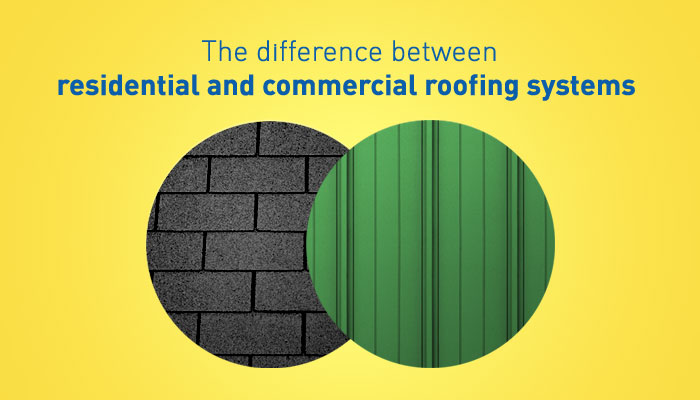
The difference between residential and commercial roofing systems
February 12th, 2020
Category: All Blogs, Maintaining your roof
Roofs are the ones that stand firm between your house interiors and the outside. Sometimes, after a long tiring day, even lying on your back and staring at the roof counts as a form of post-work relaxation time. Roofs are an essential aspect of a home as it acts as a strong shield protecting you and your dream property. Be it your home or office; roofs are installed as an efficient protective system from the environment, hot sun, harsh rains, etc. Two typical types of roofs that you can commonly find in the market are residential and commercial roofing. They have different features and cater to different structures, but they ultimately have one goal – to protect you from outside. Here is a comprehensive guide differentiating the two types of roofs.
Residential roofing systems
- Roofing systems for residential purposes generally come as slopes. These roofs are sturdy and malleable to ensure a safe shelter.
- Roofs are typically made of shingles defined as individual pieces of metal or wood that overlap each other. Note that shingles come in various shapes, sizes, and materials.
- Roofing materials play a critical role in the construction of residential roofs. A wide range of materials is used in making a residential roof ranging from wooden, asphalt, and metals. However, asphalt roofing is the most popular type of residential roof.
- Sometimes, roofs come with a protective layer below the first roof to ensure that rainwater doesn’t seep in. These shingles are subjected to change during extreme weather conditions. Thus, it is better to keep a check on your roofs periodically. In case of any damage, quickly mend the roofing system.
Types of residential roofing materials
Asphalt Roofing: The most common type of roofing material is asphalt as it is budget-friendly and durable. It is water-resistant and protects the property from extreme weather conditions. Moreover, it is easy to install and maintain.
Slate Roofing: In case you are looking for excellent material, then try slate roofing. It is available in different colors and designs and also adds to the natural appearance. Additionally, slates are long-lasting, easy to maintain, and resistant to heat and rotting.
Metal Roofing: Metal roofing is quite popular these days owing to its low maintenance and durability. The major problem with the metal roofing, however, is that it may lose color over time. In that case, repainting of the roof is advisable.
Wooden Roofing: Going back to the good old times when wood houses were prominent and famous, wooden roofing was also a part of the house. It is environment-friendly as recycled wood is used in construction. The major disadvantage of wooden roofing is that it was short-lived and requires frequent replacements.
Industrial roofing systems
Unlike the residential roofs, industrial roofs are less sloped and designed to maintain more weight, bear the excess smoke and the external pipeline running in the industries. Moreover, careful construction and regular maintenance are required for industries, especially if any sensitive operations are going on inside the industry. The roofing materials used are hard and sturdy for long-lasting performance.
Types of industrial roofing materials
The most common type of roofing material is EPDM (Ethylene Propylene Diene Monomer) which is popularly referred to as rubber roofing. It is durable and easy to install. Also, it is convenient to handle as it is light in weight. Moreover, it is cost-effective, flexible, and ductile.
Next is PVC (Polyvinyl chloride) roofing that has a long life span and is also flexible. Additionally, it is UV resistant and protects against harsh weather and fires. However, PVC roofing is expensive and difficult to maintain in the long run.
Although asphalt roofing is commonly used for homes, it doesn’t find a preference for industrial use because it doesn’t last long. It might be inexpensive, but requires regular maintenance and timely replacement.
Last is the thermoplastic roofs that are similar to rubber roofing but subject to algal attacks. It is advisable to invest in a high-quality TPO (thermoplastic polyolefin) to avoid the problems associated with it.
Installation method
Installing an industrial roof is simple when compared to residential roofs. Since slope angle is a significant feature of residential roofs, you must take careful consideration while installing them. While industrial roofs are easy to install compared to residential roofs, the whole process can be tedious. It is advisable that you get help from experts before installing the roofs. Remember that improper installation will leave your property vulnerable and susceptible to danger; therefore, it is always better to seek help.
Need help?
Bearing the key points to keep in mind before investing in a roofing system, ensure that your roofing material meets your requirement in terms of utility, location, and weather condition. For the highest quality in roofs that never let you down, check out Dura Roof!
Leave a Comment

1 Response received for this post